 W
WLieutenant-General Sir Richard Neville Anderson was a senior officer of the British Army who served in the Second World War and later achieved high office in the 1960s.
 W
WLewis Yelland Andrews (1896-1937) was an Australian soldier and colonial official who served as the District Commissioner for the region of Galilee during the British Mandate over Palestine. He was assassinated by Arab militants on his way to prayer services at Anglican Christ Church in Nazareth on 26 September 1937.
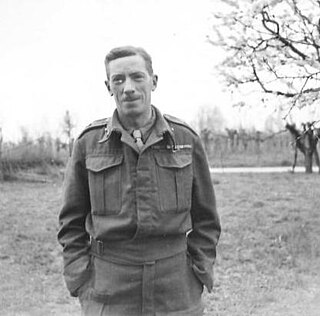 W
WMajor General Robert Keith Arbuthnott, 15th Viscount of Arbuthnott, was a senior British Army officer who served in both the First World War and the Second World War.
 W
WGeneral Sir (Charles) Clement Armitage, was a British Army officer who commanded 1st Infantry Division shortly before World War II.
 W
WLieutenant-General Sir Colin Muir Barber & Bar was a senior British Army officer who fought in both World War I and World War II where he commanded the 15th (Scottish) Infantry Division during their actions across Northwest Europe, from August 1944 until Victory in Europe Day in May 1945. Barber was reputed to be the tallest officer in the British Army, and thus earned the ironic nickname "Tiny".
 W
WGeneral Sir Evelyn Hugh Barker was a British Army officer who saw service in both the First World War and the Second World War. During the latter he commanded the 10th Brigade during the Battle of France in 1940, and the 49th Infantry Division and later VIII Corps in the Western Europe Campaign from 1944 to 1945.
 W
WLieutenant General Michael George Henry Barker was a British Army officer who fought in both world wars, notably as commander of I Corps during the Battle of France in May 1940.
 W
WLieutenant General Sir Edric Montague Bastyan, was a senior British Army officer, who became Governor of South Australia from 4 April 1961 until 1 June 1968 then Governor of Tasmania from 2 December 1968 until 30 November 1973. He was the last British person to be governor of either state.
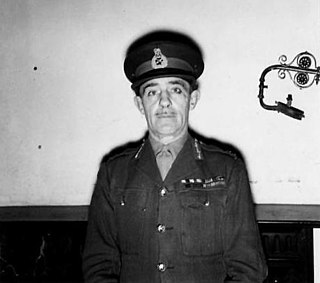 W
WMajor General Horatio Pettus Mackintosh Berney-Ficklin, was a British Army officer who served in both the First and Second World Wars. During the latter, he commanded for just over three years – from July 1940 until August 1943 – the 5th Infantry Division, the most widely travelled division of the British Army during the Second World War.
 W
WSir John Gawen Carew Pole, 12th Baronet was a Cornish landowner, soldier and politician. He was Chairman of Cornwall County Council from 1952 to 1963 and Lord Lieutenant of Cornwall from 1962 to 1977, briefly serving in both roles simultaneously. His name until 1926 was John Gawen Pole-Carew.
 W
WMajor General Basil Aubrey Coad, was a senior British Army officer. He held battalion, brigade and divisional commands during the Second World War and immediately after, but is best known as the commander of the 27th British Commonwealth Brigade during the Korean War.
 W
WField Marshal Sir John Greer Dill, was a senior British Army officer with service in both the First World War and the Second World War. From May 1940 to December 1941 he was the Chief of the Imperial General Staff (CIGS), the professional head of the British Army, and subsequently in Washington, D.C., as Chief of the British Joint Staff Mission and then Senior British Representative on the Combined Chiefs of Staff (CCS), played a significant role during the Second World War in the formation of the "Special Relationship" between the United Kingdom and the United States.
 W
WBrigadier Bernard Edward Fergusson, Baron Ballantrae, was a British Army officer, a military historian and the last British-born Governor-General of New Zealand.
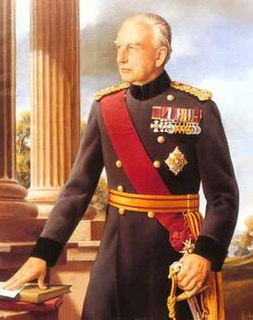 W
WGeneral Sir Geoffrey Richard Desmond Fitzpatrick, was a senior British Army officer who served as commander of the British Army of the Rhine and Deputy Supreme Allied Commander Europe. After his retirement from the army he was appointed Lieutenant Governor of Jersey and later held a ceremonial position in the Royal Household.
 W
WMajor-General John Dutton "Johnny" Frost, was an airborne officer of the British Army best known for being the leader of the small group of British airborne troops that actually arrived at Arnhem bridge during the Battle of Arnhem in Operation Market Garden, in World War II. He was one of the first to join the newly formed Parachute Regiment and served with distinction in many wartime airborne operations, such as in North Africa and Sicily and Italy, until his injury and subsequent capture at Arnhem. He retired from the army in 1968 to become a beef cattle farmer in West Sussex.
 W
WGeneral Sir Alfred Reade Godwin-Austen was a British Army officer who served during World War I and World War II.
 W
WMajor General Douglas Alexander Henry Graham, was a senior British Army officer who fought with distinction in both world wars. He is most notable during the Second World War for commanding the 153rd Brigade of the 51st (Highland) Division in North Africa from 1942 to 1943, later being the General Officer Commanding (GOC) of the 56th (London) Infantry Division during the Salerno landings in Italy in September 1943 and the 50th (Northumbrian) Infantry Division during the Normandy landings in France in June 1944.
 W
WGeneral Sir Robert Hadden Haining, was a senior British Army officer during the Second World War.
 W
WBrigadier Percy Howard Hansen, was a British Army officer and recipient of the Victoria Cross, the highest award for gallantry in the face of the enemy that can be awarded to personnel of the British and Commonwealth forces.
 W
WGeneral Sir Charles Henry Pepys Harington, was an officer in the British Army. He served in the British Expeditionary Force and in Normandy during World War II. He was later Commander-in-Chief of the three-service Middle East Command from 1963 to 1965, based at Aden. He ended his military career as Chief of Personnel and Logistics at the UK Ministry of Defence from 1968 to 1971.
 W
WMarshal of the Royal Air Force Sir Arthur Travers Harris, 1st Baronet,, commonly known as "Bomber" Harris by the press and often within the RAF as "Butcher" Harris, was Air Officer Commanding-in-Chief (AOC-in-C) RAF Bomber Command during the height of the Anglo-American strategic bombing campaign against Nazi Germany in the Second World War.
 W
WLieutenant General Sir John Ledlie Inglis Hawkesworth, was a senior British Army officer who served during both World Wars. During the Second World War he commanded the 4th Division during the Tunisian Campaign in early 1943, later commanding the 46th Division throughout most of the Italian Campaign and, finally, X Corps in Greece, before suffering from a fatal heart attack in June 1945.
 W
WAir Chief Marshal Sir Roderic Maxwell Hill, was a senior Royal Air Force commander during the Second World War. He was a former Rector of Imperial College and Vice-Chancellor of London University. The Department of Aeronautics of Imperial College was situated in a building named after him.
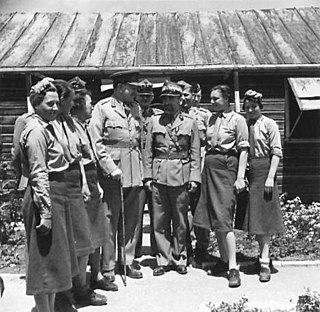 W
WLieutenant General Sir Balfour Oliphant Hutchison, was a Scottish soldier who served in both the First and Second World Wars.
 W
WSir Thomas Jacomb Hutton, KCB, KCIE, MC & bar was a British Army officer who held a variety of vital staff appointments between World War I and World War II, ultimately commanding the Burma Army during the early stages of the Japanese conquest of Burma in early 1942.
 W
WBrigadier Manley Angell James, was a British Army officer and an English recipient of the Victoria Cross, the highest award for gallantry in the face of the enemy that can be awarded to British and Commonwealth forces.
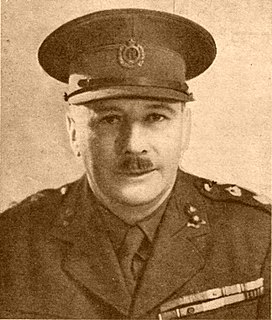 W
WFrederick Hermann Kisch CBE, CB, DSO was a decorated British Army officer and Zionist leader. A Brigadier, he was the highest ranking Jew to serve in the British Army.
 W
WAdmiral Sir Charles Edward Madden, 2nd Baronet, GCB followed his father in a career with the Royal Navy that culminated in his serving as the Commander-in-Chief of the Home Fleet from 1963 to 1965.
 W
WField Marshal Bernard Law Montgomery, 1st Viscount Montgomery of Alamein,, nicknamed "Monty" and "The Spartan General", was a senior British Army officer who served in the First World War, the Irish War of Independence and the Second World War.
 W
WBrigadier Edmund Charles Wolf Myers, more commonly known as Eddie, was a British Army officer who fought in World War II. Myers was an officer in the Royal Engineers.
 W
WBrigadier John Sebastian Nichols, was a British Army officer who fought during both the First World War and the Second World War. During the latter his most notable role was when he commanded the 50th (Northumbrian) Infantry Division during the Second Battle of El Alamein and in the Tunisian Campaign from 1942 to 1943.
 W
WGeneral Sir Richard Nugent O'Connor, was a senior British Army officer who fought in both the First and Second World Wars, and commanded the Western Desert Force in the early years of the Second World War. He was the field commander for Operation Compass, in which his forces destroyed a much larger Italian army – a victory which nearly drove the Axis from Africa, and in turn, led Adolf Hitler to send the Afrika Korps under Erwin Rommel to try to reverse the situation. O'Connor was captured by a German reconnaissance patrol during the night of 7 April 1941 and spent over two years in an Italian prisoner of war camp. He eventually escaped after the fall of Mussolini in the autumn of 1943. In 1944 he commanded VIII Corps in the Battle of Normandy and later during Operation Market Garden. In 1945 he was General Officer in Command of the Eastern Command in India and then, in the closing days of British rule in the subcontinent, he headed Northern Command. His final job in the army was Adjutant-General to the Forces in London, in charge of the British Army's administration, personnel and organisation.
 W
WAir Chief Marshal Sir Richard Edmund Charles Peirse, was a senior Royal Air Force commander.
 W
WAdmiral of the Fleet Sir Alfred Dudley Pickman Rogers Pound, was a British senior officer of the Royal Navy. He served in the First World War as a battleship commander, taking part in the Battle of Jutland with notable success, contributing to the sinking of the German cruiser Wiesbaden. He served as First Sea Lord, the professional head of the Royal Navy, for the first four years of the Second World War. In that role his greatest achievement was his successful campaign against the German U-boats and the winning of the Battle of the Atlantic but his judgment has been questioned over the failed Norwegian Campaign in 1940, his dismissal of Admiral Dudley North in 1940, and Japan's sinking of Prince of Wales and Repulse in late 1941. His order in July 1942 to disperse Convoy PQ 17 and withdraw its covering forces, to counter a threat from heavy German surface ships, led to its destruction by submarines and aircraft. His health failed in 1943 and he resigned, dying shortly thereafter.
 W
WMajor General William Havelock Chaplin Ramsden, was a senior British Army officer, who is most notable for commanding the 50th (Northumbrian) Infantry Division during the Second World War.
 W
WGeneral Sir Neil Methuen Ritchie, was a British Army officer who saw service during both the world wars. He is most notable during the Second World War for commanding the British Eighth Army in the North African campaign from November 1941 until being dismissed in June 1942. Despite this, his career did not end. Richie later commanded XII Corps throughout the campaign in Northwest Europe, from June 1944 until Victory in Europe Day in May 1945.
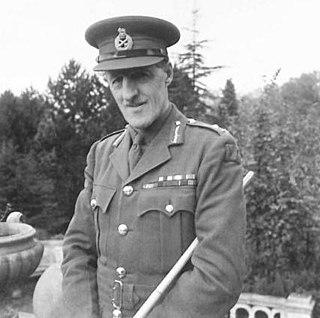 W
WMajor General Robert Knox Ross was a senior British Army officer who, during World War II, commanded the 53rd (Welsh) Infantry Division throughout the campaign in North-West Europe from June 1944 until May 1945.
 W
WMajor General Frank Keith Simmons, was a senior British Army officer during the Second World War. He was commander of the Singapore Fortress when it fell to the invading Imperial Japanese Army in February 1942. He spent the remainder of the war as a prisoner of the Japanese.
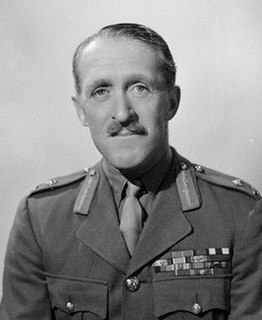 W
WMajor General William Donovan Stamer CB, CBE, DSO, MC was a British Army officer who was commissioned into the North Staffordshire Regiment at the outbreak of the First World War and served in the Army until retirement in 1948, finishing his career with the temporary rank of major-general and serving as General Officer Commanding Sudan and Eritrea.
 W
WGeneral Sir James Stuart Steele was a senior British Army officer who served as Adjutant-General to the Forces.
 W
WMajor General George William Symes, was a senior British Army officer who served in the First World War, in which he was twice awarded the Military Cross. During the Second World War he commanded the 70th Infantry Division in India, and was deputy commander of the Special Force, commonly known as the Chindits, in Burma. He was deputy commander of the lines of communication of the 21st Army Group from May to November 1944, and then commanded the lines of communication in South East Asia Command (SEAC). In June 1945, he became general officer commanding (GOC) in Southern Burma.
 W
WField Marshal Sir Gerald Walter Robert Templer, was a senior British Army officer who fought in both the world wars. As Chief of the Imperial General Staff, the professional head of the British Army, from 1955–58, he was Prime Minister Anthony Eden's chief military adviser during the Suez Crisis. He is also credited as a founder of the United Kingdom's National Army Museum.
 W
WGeneral Sir Augustus Francis Andrew Nicol Thorne, was a senior British Army officer who served in the First and Second World Wars, where he commanded the 48th Infantry Division during the Battle of France in 1940.
 W
WMajor General Robert Elliott "Roy" Urquhart, was a British Army officer who saw service during the Second World War and Malayan Emergency. He became prominent for his role as General Officer Commanding the 1st Airborne Division, which fought with great distinction, although suffering very severe casualties, in the Battle of Arnhem during Operation Market Garden in September 1944.
 W
WGeneral Sir Arthur Grenfell Wauchope was a British soldier and colonial administrator.
 W
WField Marshal Archibald Percival Wavell, 1st Earl Wavell, was a senior officer of the British Army. He served in the Second Boer War, the Bazar Valley Campaign and World War I, during which he was wounded in the Second Battle of Ypres. He served in the Second World War, initially as Commander-in-Chief Middle East, in which role he led British forces to victory over the Italians in western Egypt and eastern Libya during Operation Compass in December 1940, only to be defeated by the German Army in the Western Desert in April 1941. He served as Commander-in-Chief, India, from July 1941 until June 1943 and then served as Viceroy of India until his retirement in February 1947.
 W
WMajor Archibald John Arthur Wavell, 2nd Earl Wavell, MC was a British Army officer and peer. He was educated at Winchester College and succeeded his father as Earl Wavell and Viscount Keren of Eritrea in 1950. Wavell was killed in the Mau Mau Uprising, and the titles became extinct on his death.
 W
WLieutenant-General Sir Harry Edward de Robillard Wetherall, was an officer in the British Army during the First and Second World Wars.
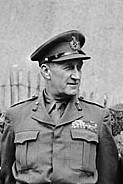 W
WGeneral Sir Lashmer Gordon Whistler,, known as "Bolo", was a British Army officer who served in both the world wars. A junior officer during the First World War, during the Second World War he achieved senior rank serving with Field Marshal Sir Bernard Montgomery in North Africa and North-western Europe from 1942 to 1945. Montgomery considered that Whistler "was about the best infantry brigade commander I knew". In peacetime, his outstanding powers of leadership were shown in a series of roles in the decolonisation process, and he reached the four-star rank of a full general, without having attended the Staff College, Camberley, then considered almost essential for an officer wishing to attain high rank, and which a significant majority of the British generals of the war had attended. This, in Richard Mead's words, was "proof that lacking a Staff College qualification was no barrier to advancement for the right man."
 W
WMajor General Orde Charles Wingate, was a senior British Army officer known for his creation of the Chindit deep-penetration missions in Japanese-held territory during the Burma Campaign of the Second World War.